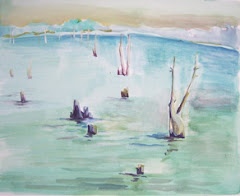
The city of New Orleans sits to the right in this picture.
The view all around is of water.
The reason I have named this post Glass Half Full is because someone said that to me today. A white man in the French quarter tourist info booth. He told me that was how most New Orleans people viewed the situation. I don’t know if that is really true or not--it might just be a bit of positive spin for the tourists.
New Orleans is surrounded by water.
That is a fact.
Mayor Nagan has come out saying he supports self-determination in what will happen in the various neighborhoods.



Grass plugs planted by volunteers to try to save the wetlands
The preservation of New Orleans Depends on Healthy Wetlands
We visited Bayou Sauvage-possibly the largest national wildlife refuge within a city, located in the east of New Orleans. The Hydrology (movement of water due to seasonal changes) is artificially managed because the levees have interrupted the natural hydrology. Gates to control the water levels mimic the seasonal changes.

Brandon explains some wetland facts

Dry cracked mud and garbage =unhealthy wetland.
We stopped at the point where a barge broke through and destroyed the wetland. Volunteers have replaced a lot of the grasses called Spatina Acturnal flora. You can see there is still a need for more.

HUGE oil refinery (one of many) that sits just outside New Orleans.
New Orleans refines and ships through its port a lot of the country’s oil. This process has had a detrimental effect on the wetlands.
Thats it for tonight.
Best, suzanne


















